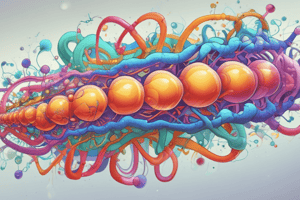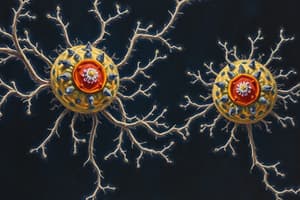Podcast
Questions and Answers
Match the following scientists with their major contributions to microbiology:
Match the following scientists with their major contributions to microbiology:
Robert Koch = Established the germ theory of disease Carolus Linnaeus = Developed the system of binomial nomenclature Louis Pasteur = Discovered pasteurization and disproved spontaneous generation Ignaz Semmelweis = Advocated for handwashing to prevent puerperal fever
Match each domain with its corresponding cell type and characteristics:
Match each domain with its corresponding cell type and characteristics:
Bacteria = Prokaryotic cells with peptidoglycan in cell walls Archaea = Prokaryotic cells lacking peptidoglycan; often found in extreme environments Eukarya = Eukaryotic cells with membrane-bound organelles Animalia = Multicellular organisms composed of eukaryotic cells that obtain nutrients by ingestion
Match each chemical element with its atomic weight:
Match each chemical element with its atomic weight:
Oxygen (O) = 16 Carbon (C) = 12 Hydrogen (H) = 1 Nitrogen (N) = 14
Match the types of chemical bonds with their descriptions:
Match the types of chemical bonds with their descriptions:
Match the macromolecules with their respective monomers:
Match the macromolecules with their respective monomers:
Match each term with its correct definition regarding pH and solutions:
Match each term with its correct definition regarding pH and solutions:
Associate each unit of measurement with its equivalent in meters:
Associate each unit of measurement with its equivalent in meters:
Match the type of microscopy with its suitable usage.
Match the type of microscopy with its suitable usage.
Match the bacterial structure with its primary function:
Match the bacterial structure with its primary function:
Match the following transport mechanisms with their description:
Match the following transport mechanisms with their description:
Match the flagellar arrangement with its description:
Match the flagellar arrangement with its description:
Match the term with its correct definition related to solutions and cells:
Match the term with its correct definition related to solutions and cells:
Match the type of inclusion with its primary storage material:
Match the type of inclusion with its primary storage material:
Match the antibiotic with its target:
Match the antibiotic with its target:
Associate the process with its explanation of genetic material transfer in bacteria:
Associate the process with its explanation of genetic material transfer in bacteria:
Match the component of an endospore with its function:
Match the component of an endospore with its function:
Match each scientist with their contribution related to disproving spontaneous generation or developing germ theory:
Match each scientist with their contribution related to disproving spontaneous generation or developing germ theory:
Match the lipid type with its primary components:
Match the lipid type with its primary components:
Match the staining technique with its primary purpose:
Match the staining technique with its primary purpose:
Match the bacterial structure with its function:
Match the bacterial structure with its function:
Match the term with what results from the removal of the cell wall in bacteria:
Match the term with what results from the removal of the cell wall in bacteria:
Match the microbial structure with its functional role:
Match the microbial structure with its functional role:
Place these steps of Gram staining in the correct order:
Place these steps of Gram staining in the correct order:
Match the microscope component with its function:
Match the microscope component with its function:
Flashcards
Microorganism benefits
Microorganism benefits
Microorganisms are used to synthesize products like riboflavin, acetone, and insulin.
Linnaean classification
Linnaean classification
The formal system for classifying and naming organisms was developed by Carolus Linnaeus.
Three-domain system
Three-domain system
The three-domain system includes Bacteria, Archaea, and Eukarya; not Animalia.
Molecular weight of ethanol
Molecular weight of ethanol
Signup and view all the flashcards
Chemical bond in water
Chemical bond in water
Signup and view all the flashcards
Components of genes
Components of genes
Signup and view all the flashcards
pH of human blood
pH of human blood
Signup and view all the flashcards
Gram stain purpose
Gram stain purpose
Signup and view all the flashcards
Binary Fission
Binary Fission
Signup and view all the flashcards
Osmotic Lysis
Osmotic Lysis
Signup and view all the flashcards
Facilitated Diffusion
Facilitated Diffusion
Signup and view all the flashcards
Endospores
Endospores
Signup and view all the flashcards
Pili vs Fimbriae
Pili vs Fimbriae
Signup and view all the flashcards
Active Transport
Active Transport
Signup and view all the flashcards
Gas Vacuole
Gas Vacuole
Signup and view all the flashcards
Plasma Membrane Permeability
Plasma Membrane Permeability
Signup and view all the flashcards
Spontaneous Generation
Spontaneous Generation
Signup and view all the flashcards
Robert Koch's Contributions
Robert Koch's Contributions
Signup and view all the flashcards
Simple Lipids
Simple Lipids
Signup and view all the flashcards
Differential Staining
Differential Staining
Signup and view all the flashcards
Isolated Colony Cells
Isolated Colony Cells
Signup and view all the flashcards
Cell Membranes in Prokaryotes
Cell Membranes in Prokaryotes
Signup and view all the flashcards
Endospores Characteristics
Endospores Characteristics
Signup and view all the flashcards
Bacterial Adhesion Structure
Bacterial Adhesion Structure
Signup and view all the flashcards
Study Notes
Multiple Choice Questions - Biology 1011 Pretest Exam 1
- Question 1: Common commercial benefits of microorganisms include the synthesis of riboflavin, acetone, and insulin.
- Question 2: The formal system for classifying and naming organisms was developed by Carolus Linnaeus.
- Question 3: Archaea is NOT a domain in the three-domain system; it is one of the domains. Other domains include bacteria and eukarya.
- Question 4: The molecular weight of ethanol (C2H5OH) is 46.
- Question 5: A covalent bond holds hydrogen and oxygen atoms together in a single H2O molecule.
- Question 6: Genes consist of proteins.
- Question 7: Blood maintains a neutral pH (around 7) and contains buffers which prevent drastic pH changes. Attempts to alter pH are impractical.
- Question 8: 1 mm is equal to 1,000 µm, 1,000,000 nm etc.
- Question 9: A phase-contrast microscope is used to see internal structures of cells in their natural state, without staining.
- Question 10: A Gram stain is useful in determining which antibiotic to prescribe for a bacterial infection.
- Question 11: Prokaryotic cells lack a membrane-enclosed nucleus and other membrane-bound organelles.
- Question 12: Placing a bacterial cell in a 5% NaCl solution results in water moving out of the cell, causing it to shrink and not undergo lysis.
- Question 13: Antibiotics that target cell wall synthesis cause cell death via osmotic lysis.
- Question 14: The image labeled 'Figure 1' shows a bacterial cell with peritrichous flagella.
- Question 15: Cells use active transport to move needed items against concentration gradients.
- Question 16: Oxygen, being a smaller, nonpolar molecule, can readily diffuse across membranes. Glucose, being larger and polar, requires facilitated diffusion.
- Question 17: A gas vacuole is a cellular structure used by certain bacteria to orient themselves in a fluid environment.
- Question 18: Endospores are highly resistant to harsh environmental conditions due to factors like dipicolinic acid (DPA), low water content, and a thick spore coat.
- Question 19: Spontaneous generation is the idea that living organisms can arise from non-living matter.
- Question 20: Robert Koch made significant contributions, including disproving spontaneous generation.
- Question 21: Simple lipids contain fatty acids and glycerol.
- Question 22: Gram staining is a differential stain used to distinguish between different types of bacteria based on the characteristics of their cell walls, producing distinct colors.
- Question 23: Cells in a single colony are genetically identical. These cells originate from a single parent cell via binary fission.
- Question 24: Protein synthesis is one of the essential functions of the cell membrane.
- Question 25: Removing the cell wall of gram-negative bacteria results in the formation of a spheroplast.
- Question 26: The cell membrane is a cellular structure common to both prokaryotic and eukaryotic cells.
- Question 27: Pili are bacterial structures that aid in adhesion.
- Question 28: Endospores are formed within bacterial cells, are resistant to boiling, and resistant to antimicrobial agents.
- Question 29: The correct order for light path in a microscope is Illuminator, condenser, objective lens, specimen, and ocular lens.
- Question 30: Prokaryotes lack a membrane-bound nucleus.
Studying That Suits You
Use AI to generate personalized quizzes and flashcards to suit your learning preferences.




